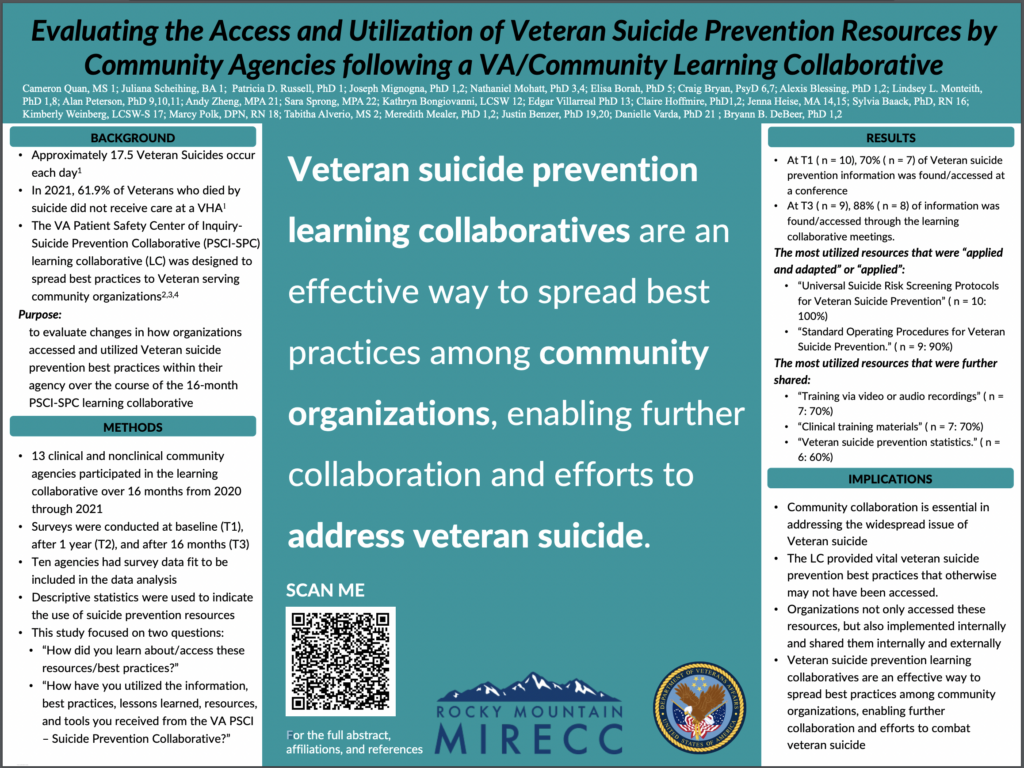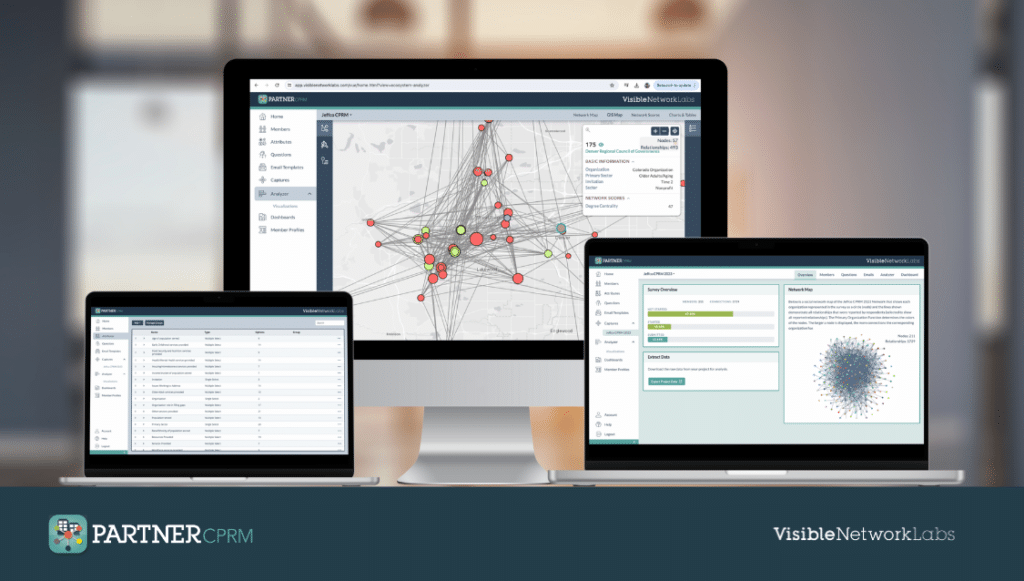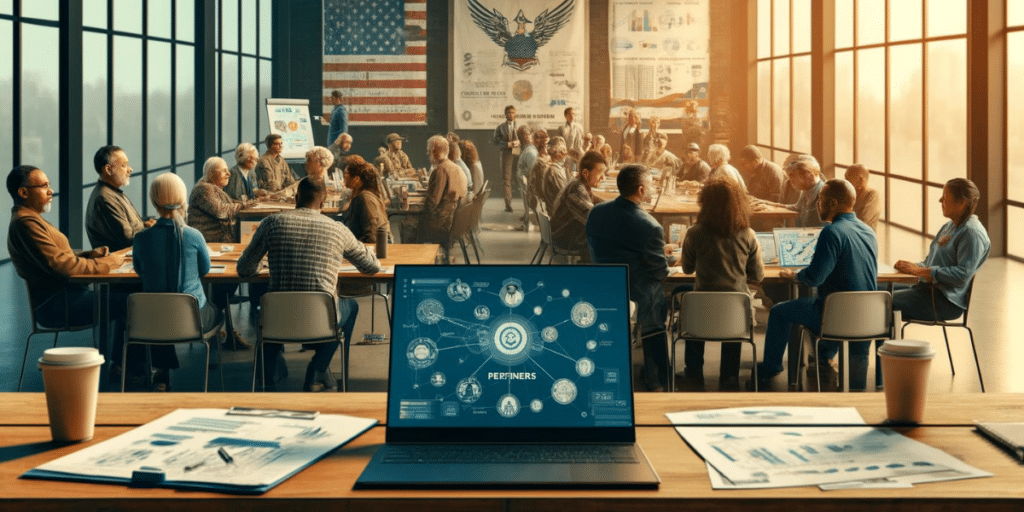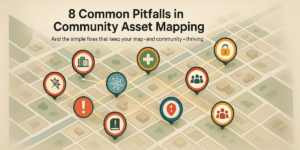Visible Network Labs recently showcased a poster presentation at the 2024 Partnerships for Veteran & Military Health Conference, highlighting a pivotal project utilizing PARTNER CPRM data in collaboration with the Department of Veterans Affairs (VA) and multiple community partners.
The poster presentation, titled “Evaluating the Access and Utilization of Veteran Suicide Prevention Resources by Community Agencies following a VA/Community Learning Collaborative,” provides crucial insights into how community agencies accessed and applied veteran suicide prevention resources.
Keep reading for more background information and a complete review of our methods, results, and the implications for veteran suicide prevention efforts.
Table of Contents
Background
Veteran suicide remains a critical public health issue, with approximately 17.5 veteran suicides occurring daily (Department of Veterans Affairs, 2023). Despite the VA’s commitment to preventing veteran suicide, a significant gap persists, as 61.9% of veterans who died by suicide in 2021 did not receive healthcare from a Veteran Health Administration facility.
The VA’s Patient Safety Center of Inquiry-Suicide Prevention Collaborative (PSCI-SPC) initiated a pilot learning collaborative to disseminate best practices to community organizations serving veterans. This collaborative aimed to enhance the access and utilization of veteran suicide prevention resources across these organizations.
Methods
The study involved 13 clinical and nonclinical community agencies participating in the learning collaborative from 2020 to 2021. Using the PARTNER CPRM platform, social network analysis (SNA) surveys were administered at three intervals: baseline (T1), after one year (T2), and after 16 months (T3). The surveys sought to answer two primary questions:
- How did organizations learn about and access veteran suicide prevention resources?
- How did they utilize the information, best practices, lessons learned, resources, and tools from the VA PSCI-Suicide Prevention Collaborative?

Results
The findings from the surveys revealed significant shifts in how veteran suicide prevention resources were accessed and utilized over time:
- At T1, 70% of veteran suicide prevention information was accessed through conferences, 30% through another collaborative member, and 10% through collaborative meetings.
- By T3, the data showed a dramatic shift, with 88% of information being accessed directly through the collaborative meetings, 50% through materials shared by the collaborative, 25% through another member, and 25% through external groups, while conference access dropped to 0%.
The most frequently adapted and applied resources within organizations were “Universal Suicide Risk Screening Protocols for Veteran Suicide Prevention” and “Standard Operating Procedures for Veteran Suicide Prevention.”
Resources that were widely shared internally and externally included “Training via video or audio recordings,” “Clinical training materials,” and “Veteran suicide prevention statistics.”
Implications
The study underscores the importance of community collaboration in addressing veteran suicide. Initially, most resources were accessed through conferences, but by the end of the learning collaborative, most information was sourced directly from collaborative meetings and materials. This shift highlights the learning collaborative’s role in providing vital veteran suicide prevention practices that might otherwise have been inaccessible.
Not only were these resources accessed, but they were also implemented within organizations and shared more broadly, amplifying their impact. This finding is particularly significant as it demonstrates the learning collaborative’s effectiveness in not just disseminating information, but also fostering its practical application within community settings.

Get our monthly newsletter with resources for cross-sector collaboration, VNL recommended reading, and upcoming opportunities for engaged in the “network way of working.”
Key Insights
Several key insights emerged from the study:
Enhanced Resource Access: The learning collaborative significantly improved access to vital suicide prevention resources. By the end of the collaborative, agencies were primarily relying on the collaborative itself for information, reducing their dependence on less consistent sources such as conferences.
Effective Utilization: Agencies not only accessed these resources but also effectively utilized them, adapting protocols and procedures to better serve veterans. This demonstrates the practical impact of the collaborative’s efforts.
Community Empowerment: The collaborative model empowered community agencies by providing them with the tools and knowledge needed to implement and share best practices. This approach enhances the overall capacity of the community to address veteran suicide.
Sustained Engagement: The transition from conference-based to collaborative-based resource access indicates a sustained engagement with the learning collaborative, suggesting that such models can create lasting change in community practices.
Conclusion
Veteran suicide prevention learning collaboratives are an effective means of disseminating best practices among community organizations. The study demonstrates that community agencies can significantly benefit from tailored programs, materials, and training that address their specific needs. By fostering such collaborative efforts, we can enhance the collective ability to combat veteran suicide and support our veterans more effectively.
Visible Network Labs is proud to contribute to such impactful initiatives through our PARTNER CPRM platform, which played a crucial role in this study by providing the necessary tools for data collection and analysis. Our commitment to leveraging network science to strengthen community partnerships aligns with the broader goal of improving public health outcomes.

See PARTNER Yourself!
For more information on how PARTNER CPRM can help your organization manage and optimize community partnerships, explore our comprehensive platform features and benefits. Experience the transformative power of network science with a personalized demo or schedule a discovery call with our expert team today.
Together, we can create stronger, more connected communities dedicated to improving veteran health and wellbeing.
Visible Network Labs (VNL) is a Colorado-based, woman-owned small business dedicated to strengthening social connectedness to improve health, mental health, and wellness outcomes. With a commitment to community engagement, data democracy, and high-quality data insights, VNL leverages the Science of Networks to support collaborative strategies and impactful outcomes. Our PARTNER CPRM platform enables organizations to map, manage, and analyze community partnerships, driving strategic decisions and fostering meaningful collaborations. Discover how we can help you achieve your community goals by visiting our website.






